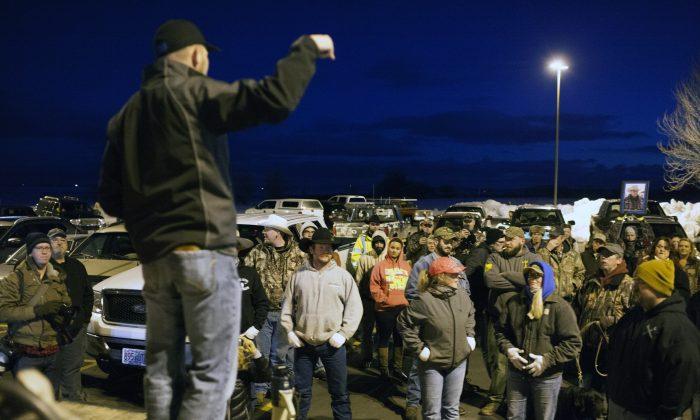BURNS, Ore.—People who live in Burns, the small high desert town near a wildlife refuge that has been occupied by an armed group for a month, say they are sick of the disruption to their lives.
“We just want to go back to the way we were,” Barbara Ormond, who owns a quilt store in downtown Burns, said Saturday. “We want everyone to leave us alone.”
Four people occupying an Oregon wildlife refuge held their position Saturday and posted live videos describing their situation and reiterating their demand that they be allowed to leave with being arrested. The jailed group’s leader, Ammon Bundy, and 10 others who were arrested earlier in the week remained in custody. Through his lawyer, Bundy on Saturday again called on the remaining occupiers to leave.
[aolvideo src=“http://pshared.5min.com/Scripts/PlayerSeed.js?sid=1759&width=580&height=356&playList=519457323&responsive=false&pgType=console&pgTypeId=discovery-videoDetails-grabCodeBtn”]
The FBI has said it’s trying to resolve the situation peacefully.
While the standoff that originated over federal land-use policies has led to filled-up hotels and restaurants as police, protesters and media have flocked to the area, locals say the conflict is upsetting and pitting neighbor against neighbor.
“It’s tearing the community apart,” said Bonnie Angleton, who owns a gift shop downtown. “I care about the people who live here.”
Kate Marsh, an artist in town, said many residents work for the government, while others have their livelihoods depend on government agencies. “There is some dissension in the community,” Marsh said.
[morearticles]1954191, 1953871[/morearticles]
Authorities say Bundy, the leader of the group that seized the Malheur National Wildlife Refuge, and others used the social media and other platforms to summon recruits to join their takeover.
Court documents against the 11 occupiers under arrest show FBI agents have scrutinized social media postings, interviews and online talk shows that have been made during the standoff that began Jan. 2.
Bundy and several other jailed leaders appeared Friday in federal court in Portland, where a judge denied their release. U.S. Magistrate Judge Stacie Beckerman said Bundy, his brother Ryan Bundy and Ryan Payne pose a danger to the community, and she is concerned they would not follow orders to return to Oregon for criminal proceedings.
[caption id=“attachment_1954474” align=“alignnone” width=“674”] An FBI agent moves a cone for a caravan of vehicles at a road block along the Malheur National Wildlife Refuge in Burns, Ore., on Jan. 30, 2016. (Matt Mills McKnight/Getty Images)[/caption]
An FBI agent moves a cone for a caravan of vehicles at a road block along the Malheur National Wildlife Refuge in Burns, Ore., on Jan. 30, 2016. (Matt Mills McKnight/Getty Images)[/caption]The only woman arrested so far in the standoff, Shawna Cox, will be allowed to go home while her case makes its way through the court system. But Beckerman said that won’t happen until after the armed occupation ends.
Ammon Bundy’s lawyer, Lissa Casey, said her client is not aligned with those remaining at the refuge near Burns and he wants to go back to his family.
Bundy and his followers took over the refuge to demand that the federal government turn public lands over to local control. They have complained about what they say are onerous federal rules governing grazing and mining rights across the West.
[aolvideo src=“http://pshared.5min.com/Scripts/PlayerSeed.js?sid=1759&width=580&height=356&playList=519456545&responsive=false&pgType=console&pgTypeId=discovery-videoDetails-grabCodeBtn”]
Court documents detail some of the evidence against the occupiers. The charges against the defendants say the refuge’s 16 employees have been prevented from reporting to work because of threats of violence.
A criminal complaint filed earlier this week makes reference to an online video that showed Bundy saying the group planned to stay for several years. He called on people to “come out here and stand,” adding: “We need you to bring your arms.”
Robert “LaVoy” Finicum, the group’s spokesman, was killed Tuesday night in a confrontation with the FBI and Oregon State Police on a remote road. Bundy and four others were arrested during the encounter.
[morearticles]1953778, 1934829[/morearticles]
At one point, a couple of dozen ranchers and other protesters were holed up at the refuge, but they began clearing out after the arrests and killing.
Lawyers for Ammon Bundy said they have recorded a phone call with their client telling the four people remaining at the refuge that it is “his authentic desire for them to stand down.” In the call released by his lawyers, Bundy said “go home to your families.”
The FBI on Thursday released a video showing Finicum’s death, to counter claims he did nothing to provoke his killing. In the aerial video, Finicum is pulled over in his truck but then takes off in the vehicle and plows into a snowbank because of a roadblock. He gets out and has his hands up at first, then appears to reach toward his jacket pocket at least twice. He is shot and falls to the snow.
The FBI said a loaded handgun was found in the pocket.





